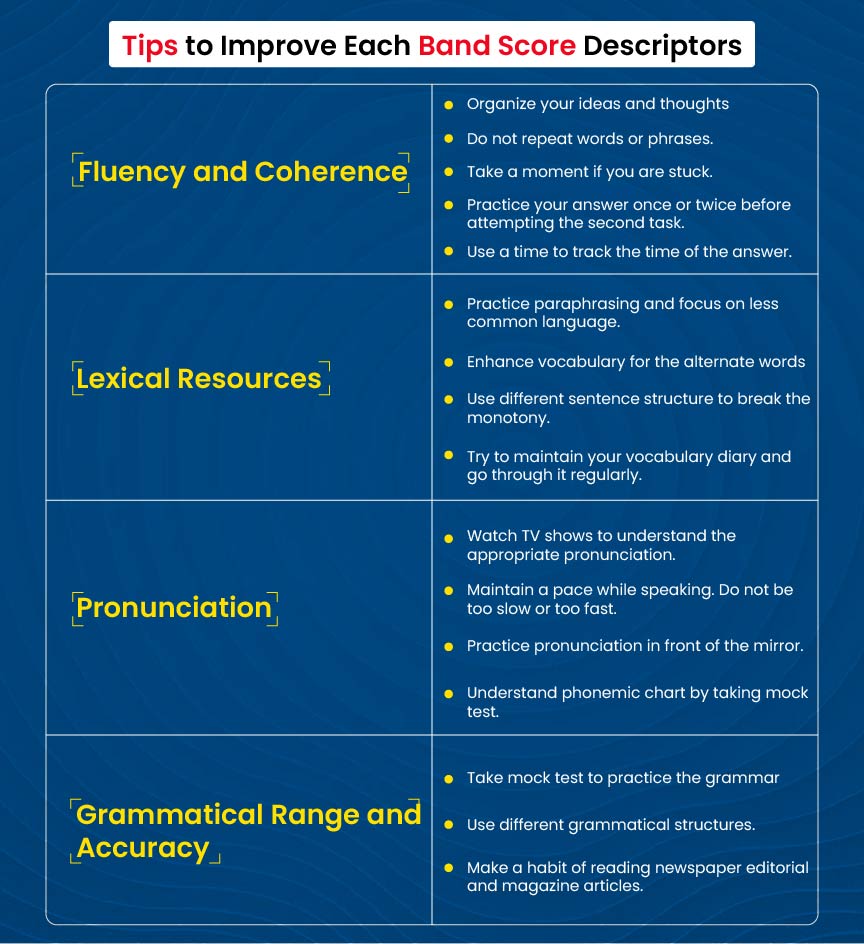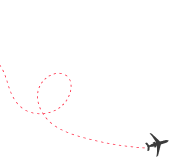The speaking section of the IELTS involves a short, face-to-face interview to determine the speaking ability of the applicant. However, the band scores are marked aligning the criteria which are known as IELTS speaking band descriptors. These include fluency, coherence, pronunciation, lexical resources along with grammatical range and accuracy. All of them are explained in this blog. Also, you will find the tips to ace each criteria along with the way to clear the speaking section of the language proficiency test.

Table of Contents
The IELTS speaking band descriptors are the factors that determine the speaking abilities of the test taker. The IELTS speaking band score chart starts from 0 (lowest) and ends at 9(highest). There are four types of speaking band descriptors for IELTS. They are as follows:
The examiner evaluates your speaking skills on the basis of these descriptors. Further, they assign a band score for each IELTS speaking band descriptors. To know these, you have to understand IELTS exam pattern. In the next section, we will know about these factors in detail.
There are nine bands and four IELTS speaking band descriptors to assess the IELTS speaking section. In this section, you will about them in detail.
It refers to the capacity of an individual to speak at a regular pace and continuity. Moreover, the test taker can link the ideas and words to produce coherent, and connected sentences. Refer to the table below to know the key indicators.
| Fluency | Coherence |
|---|---|
| The speech rate must not too slow or too fast. | The spoken sentences must be logically sequenced. |
| The flow of speech must not be ideally excessively interrupted. These can be false starts, backtracking, functionless repetitions of words and phrases, and/or pausing during which the test taker searches for words. | Usage of cohesive device is a must. It includes logical connectors, pronouns and conjunctions. |
To improve fluency and coherence, you can practice the speaking cue cards with Gradding. The experts will tell you the mistakes and areas of improvement.
One of the band descriptors for IELTS speaking section is lexical resources. This refers to the wide range of vocabulary that a test taker uses. It can influence the range of topics that they can discuss with precision. The key indicators are:
So, it means that you must have a strong vocabulary for IELTS exam. Now, let’s understand the accuracy and grammar range.
Another scoring criteria for IELTS speaking section is grammatical range and accuracy. This refers to the accurate and appropriate use of syntactic forms in order to meet speaking test requirements. The test taker can go through the dictation words for IELTS which will help to determine the complexity of words that can be used. The key factors are explained in the table below.
| Grammatical Range | Accuracy |
|---|---|
| The use of subordinate clauses within clauses and phrases must be appropriate. | The error density affects your scores both positively and negatively. |
| There must be a range of sentence structures in order to move elements around for information focus. | The communicative effect of error is considered with respect to precision and expression. |
The IELTS speaking band scores are influenced by pronunciation too. Moreover, it refers to the precise and consistent application of many phonological traits to communicate important ideas. The key indicators are as follows:
These were the marking criteria of the speaking section of the IELTS exam. Now, it is time to understand how they align with the IELTS speaking band scores. Let’s explore.
Every band has a different meaning. Let’s know the IELTS speaking scoring criteria for each band.
| Band | Fluency and Coherence | Lexical Resources | Grammatical Range and Accuracy | Pronunciation |
|---|---|---|---|---|
| 9 | Speaks fluently and coherently with appropriate sounds and wide range of vocabulary. | Total flexibility and precise use in all contexts. Sustained use of accurate and idiomaticlanguage. | Structures are precise and accurate at all times, apart from mistakes and characteristic of native speaker speech. | Uses a full range of phonological features to convey precise and/or subtle meaning. Flexible use of features. Accent has no effect on intelligibility. |
| 8 | Fluent with very few repetition or self-correction. Coherent topic development and occasional content related hesitation. | Flexible and wide range of discuss the topics to convey precise sentences. Can paraphrase as required. Use of uncommon phrases with little inaccuracies. | Variety of structure can be used with flexibility. Most of the sentences are error-free. Some basic errors can persist. | Wide range of phonological features. Can sustain appropriate rhythm. Stress and intonation can be used with flexibility. |
| 7 | Can keep going and produce long turns without noticeable efforts. Flexible use of spoken discourse markers, connectives and cohesive features. | Discusses a variety of topics with flexible resources. Some ability to use less common and idiomatic items. Effective use of paraphrase can be done. | Frequent error-free sentences with a range of flexible structures. Some errors can be seen in both simple and complex sentences. | Displays all the positive features of band 6, and some, but not all, of the positive aspects of band 8. |
| 6 | Ability to keep going and willingness to produce long turns. Sometimes, coherence is lost due to hesitation, repetition or self-correction. | Can discuss the topic at length with sufficient resources. Sometimes the vocabulary is wrong but sentence meaning is clear. | Produces a mix of short and complex sentences but the flexibility is limited. | Uses a range of phonological feature with variable control. Can use effective intonation and stress but is not sustained. |
| 5 | Relies on repetition and self-correction Often hesitates and overuse certain discourse markers. | Sufficient word range to discuss familiar and unfamiliar topics but the flexibility is limited. | Basic sentence forms are accurate. Also, the complex structures ate attempted with a range limit. | Displays the positive feature of band 4 and some positive aspects of band 6. |
| 4 | The pauses are noticeable and often self-corrects. Also, breakdown in coherence is observed. | The vocabulary is sufficient for familiar topics and can convey only basic meaning on unfamiliar topics. | Short and basic utterances are error-free. There are some rare subordinate clauses. | The range is limited but uses some acceptable phonological features. |
| 3 | Frequent pauses while searching for appropriate word. Limited ability to link simple sentences. | Inadequate vocabulary for unfamiliar topics. Also, simple vocabulary is used to convey personal information. | Basic sentence forms are attempted but there are many grammatical errors. | Displays some features of band 2 and some positive aspect of band 4. |
| 2 | Takes many pauses. | Speaks memorized answers. | Can not build basic sentences. | No meaning in the spoken sentences. |
| 1 | No fluency and speech is incoherent. | Communication is not possible. | Only memorized answers. | Can not convey meaningful sentences but can produce individual words occasionally. |
| 0 | Does not attend | Does not attend | Does not attend | Does not attend |
In this table, you came across IELTS speaking public band descriptors and their criteria.
The arithmetic mean is used to calculate the IELTS speaking band score chart. The overall IELTS speaking score is computed as a total of all the band scores and further divided by 4. For instance, if a student gets 8, 6, 8, and 6 band scores for each of the following criteria: fluency and coherence, pronunciation, lexical resource, and grammatical range and accuracy. Then it will be 8+6+8+6 = 28. Further, it will be divided by 4 to get 7. The chart of IELTS speaking band score, therefore, is as follows.
| Speaking Assessment Criteria | Band Score |
|---|---|
| Fluency and Coherence | 8 |
| Lexical Resources | 6 |
| Grammatical range and Accuracy | 8 |
| Pronunciation | 6 |
| Total Speaking | 7 |
This is the way in which you can calculate the band score of the speaking section. So, if you wish to calculate the overall band score, then you can use the band score calculator tool. It helps you to know the expected score in the language proficiency exam.
Also Read: How to Use IELTS mock test to Improve Your Band Score?
The IELTS speaking band descriptors are marked separately. After combining these, overall scores are awarded. So, the test taker has to work on each aspect to ace the test in the first attempt. They can refer to the image below to know the ways to improve every factor.
The above image tells the ways to improve each of the IELTS speaking public band descriptors. Let’s now explore the tips to ace the speaking section of the IELTS exam.
Following these tips will help you to clear the speaking section of the IELTS exam.
In conclusion, you got to know about the speaking band descriptors for IELTS. These directly affect the band score of the candidate. Thus, it is crucial to understand these in order to ace the language proficiency exam in the first attempt. If you are still unsure, you can enroll yourself in online IELTS coaching. The experts will help you by unfolding the syllabus along with these descriptors. The certified trainers will also assist you in every step so that you don’t feel lost and stuck. Enroll today and transform your dreams into reality.
The IELTS speaking band descriptors are the factor that determines the band score of test taker in the IELTS speaking section. There are 4 descriptors which are as follows:
Yes, everything becomes easy with a proper plan. You can challenge yourself and set a target to achieve daily. Find your mistakes and work on them. Moreover, regular practice will help you ace the test in the first attempt.
Yes, a band score of 9 is achievable in the speaking section. All you need is consistent practice enhancing your vocabulary and sentence formation.
Not speaking for a full two minutes can impact the scores of the test takers negatively. Each band descriptors for IELTS speaking will have an adverse effect of being quiet.
A band score of 4 or below is considered poor in IELTS. But if your IELTS scores and college criteria align, then any score is good to go.

We are available in :
BangaloreAhmedabadJaipurHyderabadKeralaPuneChandigarhMumbaiGurgaonChennaiKolkataTrivandrumNoidaKochiCalicutKottayamKollamThrissurIndoreUdaipurdisclaimer:logos and other registered trademarks of universities used on this platform are held by their respective owners. Gradding does not claim ownership or association on them, and their use is purely for informational and illustrative purposes.




